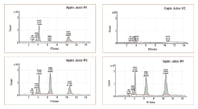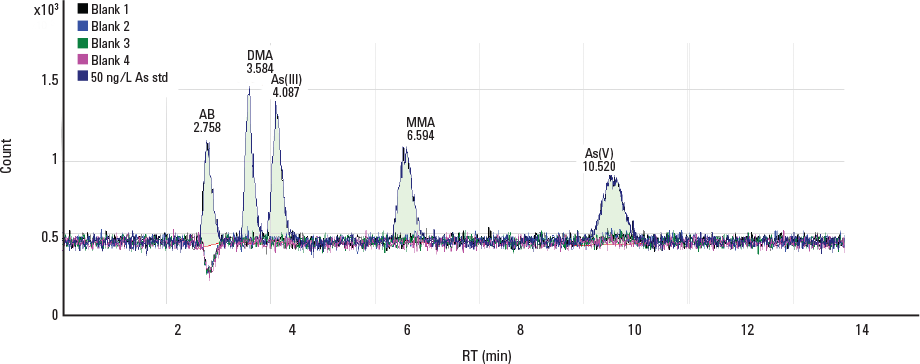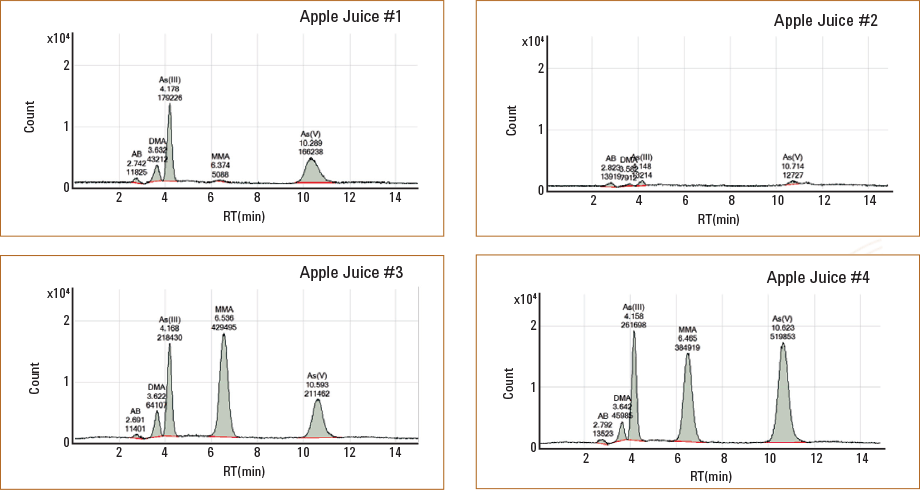Access Agilent eNewsletter, March 2015
>> Update My Profile | Subscribe to Access Agilent | Article Directory

Easy, accurate elemental speciation with Agilent HPLC/ICP-MS solutions
By Eric Vanclay
Agilent Spectroscopy Supplies Product Manager
Tetsushi Sakai
Agilent ICP-MS Applications Engineer
and Ed McCurdy
Agilent ICP-MS Product Specialist
ICP-MS is a powerful analytical tool for measuring trace and ultra-trace concentrations of metals and metalloids. The hyphenated ICP-MS technique couples a separation technique, usually chromatography, to an ICP-MS. Chromatography separates the various components in the sample and provides additional information in the form of retention time. ICP-MS then determines which metals (or elements) are present.
Speciation is one of the growing application areas for hyphenated techniques. Coupling HPLC to ICP-MS delivers simultaneous low-level detection and compound-specific identification as the species elute from the LC column. This approach is particularly attractive due to the simple and fast connection. Additionally, HPLC mobile phase chemistries and flow rates are generally compatible with ICP-MS sample introduction systems.
Hyphenation is a well-established technique with a routine, highly sensitive procedure that allows lab technicians to identify and quantitate metal species in a wide range of sample types. LC-ICP-MS answers key questions about health risks, or biological activity, as well as environmental cycling of elements and the fate of pollutants, and can help unravel complex metabolic pathways. In this article, we explore a specific example.
 Enlarge
Enlarge
Figure 1. Chromatograms for four preparation blanks confirmed undetectable levels of As species contamination, with a 50 ng/L mixed As species standard overlaid.
 Enlarge
Enlarge
Figure 2. Chromatograms for four apple juice samples, all on the same intensity scale, to highlight the different relative concentrations of each of the As species.
Easy separation and measurement of arsenic in apple juice
Recently, the European Food Safety Authority and WHO/FAO Joint Expert Committee on Food Additives and Contaminants called for accurate information on the inorganic arsenic content of foods. They concluded there is a need for improved assessments of dietary exposures to inorganic arsenic and validated methods for selective determination. For example, arsenic (As) in apple juice can exceed the US Environmental Protection Agency (US EPA) maximum contaminant level for As in drinking water (10 µg/L). Arsenic-containing agrochemicals such as lead arsenate or calcium arsenate were used for much of the 20th century as preharvest pesticides. While widespread use ceased in the 1970s, the compounds are stable and can persist in the soil long after application.
We used an Agilent 1290 Infinity LC coupled to an Agilent 7700x ICP-MS to separate and measure As species in six commercial apple juices. The same method has also been used for measuring the samples using the Agilent 8800 ICP-QQQ. Sample preparation was simple filtration and a 2x dilution in deionized water. We avoided aggressive sample digestion and large dilution factors to minimize species interconversion and ensure the lowest possible detection limits. An Agilent speciation guard column and arsenic speciation column for food/urine separated the As(III) and As(V) species, and the organic forms arsenobetaine (AB), dimethylarsinic acid (DMA), and monomethylarsonic acid (MMA).
To assess method capability, we evaluated the potential for As species contamination during sample preparation. Four different preparation blank samples were prepared to identify any possible contamination. The blanks included deionized water, filter blanks, and a method blank (deionized water filtered twice, same as for samples). Figure 1 confirms that no detectable levels of arsenic were present in the preparation blanks, measured using the Agilent 8800 ICP-QQQ.
Calibrations for the toxic inorganic As species were prepared from 10 to 500 ng/L, illustrating good sensitivity and linearity at these levels. Figure 2 shows chromatograms for four of the apple juice samples, measured using the Agilent 8800 ICP-QQQ.
Table 1 summarizes the measured arsenic concentrations in the juices (corrected for the 2x dilution factor), measured using the Agilent 7700x ICP-MS. Although As species were found in all six samples, both the total As concentration and the relative concentrations of the different species varied. While the majority of the As was in the toxic inorganic form, all the apple juice samples contained much lower levels of total As than the US EPA maximum level for drinking water (10 µg/L). The total measured concentration of As (sum of all species) was below 5 µg/L in all juice samples.
Apple juice |
AB (µg/L) |
DMA (µg/L) |
As(III) (µg/L) |
MMA (µg/L) |
As(V) (µg/L) |
|---|---|---|---|---|---|
1 |
0.036 |
0.189 |
0.724 |
N/D |
0.651 |
2 |
0.026 |
0.022 |
0.041 |
N/D |
0.058 |
3 |
0.02 |
0.267 |
0.883 |
1.587 |
0.758 |
4 |
0.039 |
0.208 |
0.992 |
1.466 |
1.958 |
5 |
0.043 |
0.209 |
1.256 |
0.785 |
0.709 |
6 |
0.036 |
0.235 |
1.098 |
N/D | N/D |
Table 1. Concentrations of five As species in six apple juice samples.
Identify and quantify compounds with confidence
These results demonstrate the suitability of hyphenated Agilent ICP-MS for analysis of As species at low µg/L levels in food and beverages, such as apple juice. Simple sample preparation, low dilution, and rapid, reliable chromatographic separation allow routine monitoring of As species. What’s more, the Agilent speciation column provides excellent peak separation and reproducibility for the most common speciation methods. Agilent speciation columns help you determine quantity and chemical species with confidence.
Agilent offers a wide range of HPLC/ICP-MS solutions
For more information, explore the Agilent Metals Speciation Columns and Supplies Flyer and Arsenic speciation analysis in apple juice Application Note, 5991-0622EN, which used this LC method coupled to an Agilent 8800 ICP-QQQ. In addition, the Agilent Speciation Handbook covers a diverse range of hyphenated techniques, including LC-ICP-MS in environmental, food safety, hydrocarbon processing, and more.
>> Update My Profile | Subscribe to Access Agilent | Article Directory

